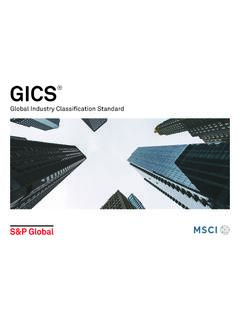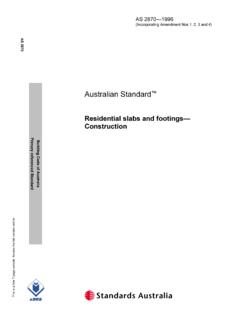Transcription of Data Center Site Infrastructure Tier Standard ... - GPX Global
1 Data Center Site Infrastructure Tier Standard : Topology1 AbstractThe Uptime Institute Tier Standard : Topology is an objective basis for comparing the functionality, capacity, and expected availability (or performance) of a particular site Infrastructure design topology against other sites, or for comparing a group of sites. This Standard describes criteria to differentiate four classifications of site Infrastructure topology based on increasing levels of redundant capacity components and distribution paths. This Standard focuses on the definitions of the four Tiers and the performance confirmation tests for determining compliance to the definitions. The Commentary, in a separate section, provides practical examples of site Infrastructure system designs and configurations that fulfill the Tier definitions as a means to clarify the Tier classification temperatures, autonomous response, availability, classification, Compartmentalization, Concurrent Maintenance, Concurrently Maintainable, Continuous Cooling, critical power distribution, data Center , dry bulb, dual power, electrical power backbone, Fault Tolerance, Fault Tolerant, functionality, Infrastructure , metrics, Operational Sustainability, performance, redundant, reliability, Tier, Tier level, Tiers, topology, wet bulbCopyrightsThis document is copyrighted by the Uptime Institute, LLC.
2 Uptime Institute in making this document available as a reference to governmental agencies, public institutions, and private users does not waive any rights in copyright to this Institute s Publications are protected by international copyright law. Uptime Institute requires written requests at each and every occasion that Uptime Institute s intellectual property or portions of the intellectual property are reproduced or used. Uptime Institute copyright extends to all media paper, electronic, and video content and includes use in other publications, internal company distribution, company Web sites and marketing materials, and handouts for seminars and more information, please visit to download a Copyright Reprint Permission Request introduction is not part of Uptime Institute Data Center Site Infrastructure Tier Standard : Topology. It provides the reader with context for the application of the Data Center Site Infrastructure Tier Standard : Topology is a restatement of the content previously published as Uptime Institute publication Tier Classifications Define Site Infrastructure Performance.
3 Selected content of this publication has been reedited into a more traditional standards model format. Future updates or changes to Uptime Institute Tier Standard : Topology shall be accomplished through a review and recommendation process consistent with other recognized standards Tier Classifications were created to consistently describe the site-level Infrastructure required to sustain data Center operations, not the characteristics of individual systems or subsystems. Data centers are dependent upon the successful and integrated operation of electrical, mechanical, and building systems. Every subsystem and system must be consistently deployed with the same site uptime objective to satisfy the distinctive Tier requirements. The most critical decision-making perspective owners and designers must consider, when making inevitable tradeoffs, is what effect does the decision have on the life-cycle-integrated operation of the information technology (IT) environment in the computer room.
4 Most successful owners align data Center site Infrastructure investment with the business case for availability or selected mission imperatives. These organizations will know the cost of a disruption, usually in terms of actual dollar costs, impact to market share, and continued mission imperatives. The cost of disruption makes the case for investment in high-availability Infrastructure a straightforward business put, the Tier topology rating for an entire site is constrained by the rating of the weakest subsystem that will impact site operation. For example, a site with a robust Tier IV UPS configuration combined with a Tier II chilled water system yields a Tier II site very stringent definition is driven by senior executives who have approved multi-million dollar investments for an objective report of actual site capabilities. Any exceptions and exclusions footnoted in the approval documents will be quickly lost and forgotten.
5 If a site has been advertised within an organization as being Fault Tolerant (Tier IV), it will be inconsistent to have to plan a site shutdown at any time in the future regardless of any fine print exclusions that diligently identified the risk. For this reason, there are no partial or fractional Tier ratings. A site s Tier rating is not the average of the ratings for the critical site Infrastructure subsystems. The site s Tier rating is the lowest of the individual subsystem , the Tier rating cannot be claimed by using calculated mean time between failures (MTBF) component statistical reliability to generate a predictive availability and then using that number to match the empirical availability results with those of sites representing the different Tier classifications. Statistically valid component values are not available, partly because product life cycles are getting shorter and no independent, industry -wide database exists to collect failure data.
6 Finally, this Standard focuses on the topology and performance of an individual site. High levels of end-user availability may be attained through the integration of complex IT architectures and network configurations that take advantage of synchronous applications running on multiple sites. However, this Standard is independent of the IT systems operating within the Factors and ExposuresUptime Institute Tier Standard : Topology and Tier Standard : Operational Sustainability establish a consistent set of performance criteria that can be satisfied, and adjudicated, worldwide. For the data Center design, implementation, and sustained operation to be successful, additional factors and exposures must also be considered by the owner and project team. Many of these will be dictated by the site location as well as local, national, or regional considerations and/or regulations. For example, building codes and Authorities Having Jurisdiction (AHJs); seismic, extreme weather (high winds, tornado); flooding; adjacent property uses; union or other organized labor force; and/or physical security (either as corporate policy or warranted by immediate surroundings).
7 Due to the many design and management options that may be dictated by the owner, regulated by local government, recommended by industry groups, or followed as a general practice, it is not feasible for Tier Standard : Topology and Tier Standard : Operational Sustainability to establish criteria for these additional factors and exposures worldwide. And, Uptime Institute does not wish to displace or confuse the guidance of local experts, which are key for timely project delivery, regulatory compliance, and implementation of best a successful project, Uptime Institute recommends that the project team create a comprehensive catalogue of project requirements, which incorporates Tier Standard : Topology, Tier Standard : Operational Sustainability, and carefully considered mitigation measures of these additional factors and exposures. This approach will ensure the project meets the compliance objectives of Uptime Institute s international standards , as well as local constraints and owner s business Overview.
8 Scope .. Purpose .. References .. Related Publications .. Tier Classification Definitions .. Tier I Basic Data Center Site Infrastructure .. Tier II Redundant Site Infrastructure Capacity Components .. Tier III Concurrently Maintainable Site Infrastructure .. Tier IV Fault Tolerant Site Infrastructure .. Engine-Generator Systems .. Ambient Temperature Design Points .. Communications .. Makeup Water .. Tier Requirements Summary .. Utility Services .. Commentary for Application of the Tier Standard : Topology .. Outcome-Based Tier Impact of Ambient Design Conditions .. Restrictions Against Engine-Generator Runtime Limitations (Tier III and Tier IV) .. Communications Routing .. Tier Functionality Progression .. Fractional or Incremental Tier Classification .. Non-Compliance Trends ..12 Modifications ..1251. ScopeThis Standard establishes four distinctive definitions of data Center site Infrastructure Tier classifications (Tier I, Tier II, Tier III, Tier IV), and the performance confirmation tests for determining compliance to the definitions.
9 The Tier classifications describe the site-level Infrastructure topology required to sustain data Center operations, not the characteristics of individual systems or subsystems. This Standard is predicated on the fact that data centers are dependent upon the successful and integrated operation of several separate site Infrastructure subsystems, the number of which is dependent upon the individual technologies ( , power generation, refrigeration, uninterruptible power sources) selected to sustain the operation. Every subsystem and system integrated into the data Center site Infrastructure must be consistently deployed with the same site uptime objective to satisfy the distinctive Tier with the requirements of each Tier is measured by outcome-based confirmation tests and operational impacts. This method of measurement differs from a prescriptive design approach or a checklist of required equipment. Commentary on this Standard is in a separate section that provides examples for the design and configuration of facility systems for each Tier topology level.
10 The commentary section also offers guidance in the application and implementation of the Tier definitions. In addition, the commentary section includes discussion and examples to aid in understanding Tier concepts as well as information on common design topology shortfalls. PurposeThe purpose of this Standard is to equip design professionals, data Center operators, and non-technical managers with an objective and effective means for identifying the anticipated performance of different data Center site Infrastructure design References American Society of Heating, Refrigerating, and Air-Conditioning Engineers, ASHRAE Handbook Fundamentals (Latest Version). ASHRAE Thermal Guidelines for Data Processing Environments, Third Related PublicationsAccredited Tier Designer Technical Paper Series Further information can be found at Site Infrastructure Tier Tier I: Basic Site Infrastructure The fundamental requirement:a) A Tier I basic data Center has non-redundant capacity components and a single, non-redundant distribution path serving the critical environment.








